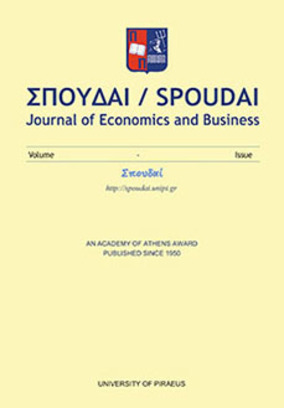Cross-sectional analysis of stock returns in Athens Stock Exchange for the period 2004-2011
Part of : Σπουδαί : journal of economics and business ; Vol.63, No.1-2, 2013, pages 100-120
Issue:
Pages:
100-120
Author:
Abstract:
This study is an investigation of the factors affecting the average returns of stocks that were traded on the Athens Stock Exchange for the period July 2004 - June 2011. The methodological approach is similar to that applied by Fama and French (1992), in the first stage, stocks are grouped into portfolios with predefined criteria, and subsequently monthly cross sectional regressions are carried out, according to the Fama-MacBeth approach (1973). The main result of this study is that average stock returns in the ASE are not associated with the market beta (market risk) and there is not a strong relationship with any other risk factor for the stocks market value or book to market ratio.
Subject (LC):
Keywords:
cross-sectional analysis, market beta, size effect
Notes:
Περιέχει εικόνες, πίνακες, σημειώσεις και βιβλιογραφία
References (1):
- Banz, R. W., 1981. The relationship between return and market value of common stocks. Journalof Financial Economics. 9, 3-18.Barbee, W. C., Jr., Mukherji, S. and Raines, G., 1996. Do Sales–Price and Debt–Equity ExplainStock Returns Better Than Book–Market and Firm Size? Financial Analysts Journal. 52,2(March/April):56-60.Basu, S., 1983. The relationship between earnings’ yield, market value, and return for NYSE commonstocks: Further evidence. Journal of Financial Economics. 12, 129-156.Bhandari, L. C., 1988. Dept/equity ratio and expected common stock returns: Empirical evidence.Journal of Finance. 43, 507-28.Black, F., 1993. Beta and return. Journal of Portfolio Management. 20(Fall), 8-18.Black, F., Jensen, M. C. and Scholes, M., 1972. The Capital Asset Pricing Model: Some EmpiricalTests. Studies in the Theory of Capital Markets (Ed. M. C. Jensen), Praeger, New York.Chan, L. K. C., Hamao and Lakonishok, J., 1991. Fundamentals and stocks returns in Japan. Journalof Finance. 46, 1739-1789.Chou, P. H., Chou, R. K., and Wang, J. S., 2004. On the Cross –section of expected Stock Returns,Fama- French ten years later. Finance Letters 2(1), 18-22.Daniel, K., Titman, S., 1997. Evidence on the characteristics of cross-sectional variation in stockreturns. Journal of Finance. 52, 1-33.Davis, J. L., Fama, E. F., French, K. R., 2000. Characteristics, covariances, and average returns:1929 to 1997. Journal of Finance. 55, 389-406.Down, T., Ingram, R., 2000. Beta, size, risk and return. The Journal of financial Research. 13, 3,245-600.Fama, E. F. and French, K. R, 1992. The Cross-Section of Expected Stock Returns. Journal of Finance.47, 427-465.Fama, E. F. and French, K. R., 2004. The capital Asset Pricing Model: Theory and Evidence. Journalof Economics. 18, 3, 25-46.Fama, E. F. and French, K. R., 1993. Common Risk Factors in the Returns on Stocks and Bonds.Journal of Financial Economics, 33, 3-56.Fama, E. F. and MacBeth, J. D., 1973. Risk, return and equilibrium: empirical tests. Journal ofPolitical Economy. 81, 607-36.Fama, E. F., and French, K. R., 1998. Value versus growth: The international evidence. Journal ofFinance 53, 1975-1999.Glezakos, M., Mylonas, P., 2004. Size Effect still present in the Athens Stock Exchange. EuropeanResearch Studies. 7, (3-4), 1-23.Hou, K., Karolyi, G. A., Kho, B. C., 2011. What fundamental factors drive global stock returns? Reviewof Financial Studies. May 2011, 1-48.Hou, K., Moskowitz, T. J., 2005. Market frictions, price delay, and the cross-section of expected returns.Review of Financial Studies. 18, 981-1020.Kim, D., 1995. The errors in the variables problem in the cross section of expected stock returns.Journal of Finance. 50, 1605-34.Kim, D., 1997. A reexamination of the firm size, book-to-market, and earnings price in the crosssectionof expected stock returns. Journal of Financial and Quantitative Analysis. 32, 463-89.Knez, P., Ready, M., 1997. On the Robustness of Size and Book-to-Market in Cross-Sectional Regressions.The Journal of Finance, 52, 4, 1355-1382.Kothari, S. P., Shanken, J. and Sloan, R. G., 1995. Another look at the cross-section of expectedstock returns. Journal of Finance. 50, 185-225.Leledakis, G., Davidson, I., 2001. Are two factors enough? The UK Evidence. Financial AnalystsJournal. November/Decemder, 96-105.Leledakis, G., Davidson, I. and Karathanassis, G., 2003. Cross-sectional estimation of stock returnsin small markets: The case of the Athens Stock Exchange. Applied Financial Economics.13, 413-426.Litzenberger R. and Ramaswamy, K., 1979. The Effects of personal taxes and dividends on capitalassets prices: Theory and empirical evidence. Journal of Financial Economics.7, 163-195.Lo, A. W. and MacKinlay, A. C., 1990. Data-snooping biases in tests of financial asset pricing models.Review of Financial Studies. 3, 431-67.Mathijs A. van Dijk, 2011. Is size dead? A review of the size effect in equity returns. Available at:http://papers.ssrn.com/sol3/papers.cfm?abstract_id=879282.Merton, R. C., 1987. A simple model of capital market equilibrium with incomplete information.Journal of Finance. 42, 483-510.Reinganum, M. R., 1981. Misspecification of asset pricing: Empirical anomalies based on earnings’yields and market values. Journal of Financial Economics, 9, 19-46.Roll, R., 1981. A Possible explanation of the Small Firm Effect. Journal of Finance, 36, 19-46.Rosenberg, B., Reid, K., Lanstein, R., 1985. Persuasive evidence of market inefficiency. Journal ofPortfolio Management 11, 9-17.Schwert, G. W., 1983. Size and stock returns, and other empirical regularities. Journal of financialEconomics, 12, 3-12.Schwert, G. W., 2002. Anomalies and Market Efficiency.Available at: http://papers.ssrn.com/sol3/papers.cfm?abstract_id=338080Siriopoulos, C., Filippas, D., 2010. Econometric Models and Applications with E-views, publ. Anikoula,Thessaloniki.




